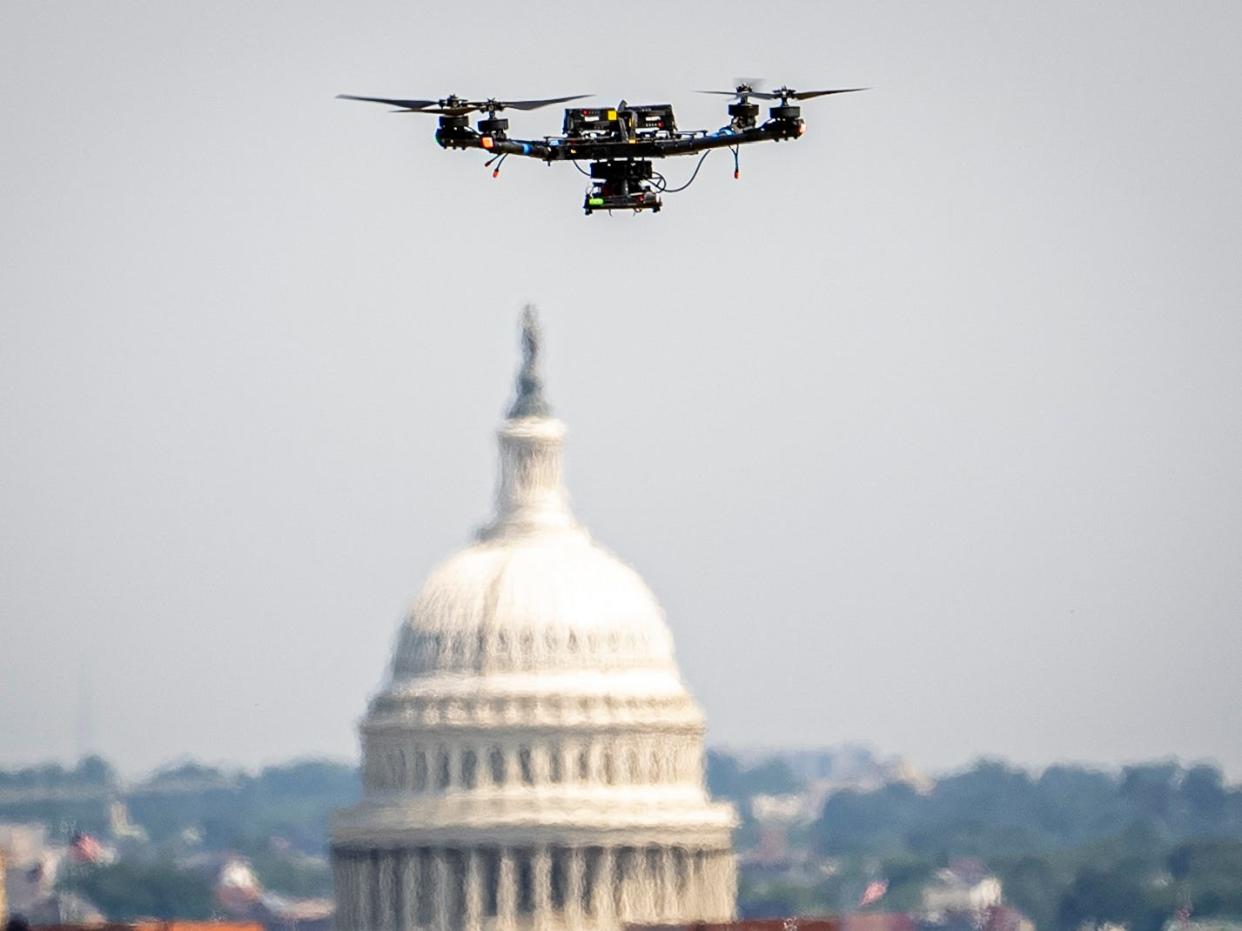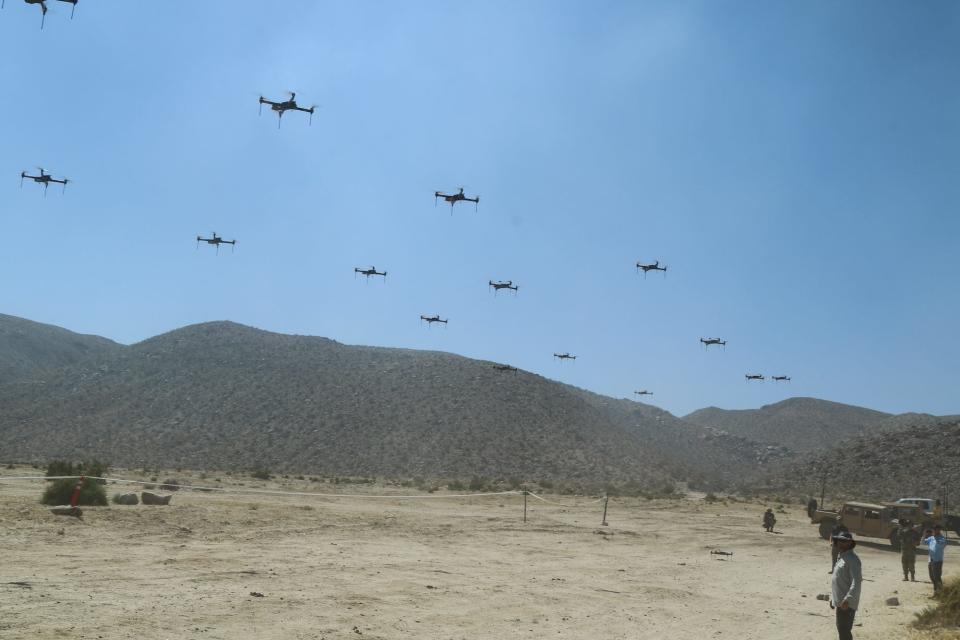Swarms of drones are a rising threat to the US homeland, and law enforcement isn't ready

Thanks to advances in drone technology, these are a growing threat inside the US.
The question isn't if intelligent drone swarms become a domestic security threat, but when.
A few extremists with exploding drones can inflict "immense damage," an expert told BI.
Even as the US military worries about swarms of hostile drones that have savaged foreign battlefields, experts warn there is a danger closer to home.
Packs of small exploding drones could devastate America's electrical grid and other critical infrastructure, or inflict mass casualties at stadiums and other crowded events, according to the report by the RAND Corp. think tank. And for now, there may not be much that law enforcement or utility companies can do to stop this.
"Vulnerabilities and consequences will likely be challenging to mitigate for homeland security defenders (e.g., law enforcement officers, first responders, planners, and workers in critical infrastructure sectors), because fielding detection systems and countermeasures across the range of potential targets could be extremely costly," said the study by RAND's Homeland Security Operational Analysis Center, which conducts research for the Department of Homeland Security.
RAND focused on various ways that terrorists inside the US could wreak havoc with drone swarms. "We consider the terrorist use of drones for attacking critical infrastructure using explosives as our primary scenario," the study said. "Excursions from that scenario include the use of an intelligent swarm armed with explosives targeting a mass gathering, a swarm with a cyber or electromagnetic attack capability targeting an electrical power substation, and a swarm being employed by smugglers for conducting reconnaissance to avoid border patrols."
The study then examined various kinds of drone swarms. Current technology allows unmanned aircraft to be employed in what RAND terms "surrogate swarm technology," in which formations are only loosely coordinated. This might include multiple drones, with each one controlled by a different operator acting in rough conjunction. Or a single operator might try to control multiple drones, or a gaggle of UAVs can be programmed to follow a lead drone.
Even 20 years ago, US special operations forces employed multi-drone attacks in Afghanistan. But it is in Ukraine that drones have emerged as arguably the decisive weapon on the modern battlefield Explosive-packed hobby drones have destroyed tanks and artillery on land, while Russian warships have been hunted and sunk by packs of naval drones. Quadcopters that cost a few hundred dollars can be fitted with explosives inside a garage workshop and then used to destroy an expensive armored vehicle.
Perhaps more significant for US homeland security is that Russia has used drones to pound Ukraine's electrical system and other infrastructure. Waves of Russian- and Iranian-made drones have allowed the Kremlin to hit Ukrainian cities without risking precious manned aircraft and pilots.
Nonetheless, all these attacks have been made with "collections of individual drones that have been programmed to follow flight plans and simultaneously attack a target or multiple targets," RAND explained. What's coming next looks much worse.
"Intelligent drone swarms," as RAND calls them, function like a hive mind of insects. Controlled by AI, and with each small drone connected wirelessly, they can optimize and modify attack planning on the spot, such as recognizing the approaches least covered by an enemy's defensive weapons and streaking in from those directions simultaneously.
For a vivid example, take a look at Alfred Hitchcock's classic 1963 horror movie "The Birds."

Nations such as America and China are busy developing military drone swarms. For example, DARPA's Offensive Swarm-Enabled Tactics (OFFSET) envisions equipping small infantry units with the capability to launch more than 250 air and ground drones during urban combat. Such technology is becoming available to the public: the FAA has already allowed limited use of drone swarms to spray crops. "Intelligent swarm technologies should become readily available within the next five to ten years," RAND predicted.
Thus the question isn't if intelligent drone swarms become a domestic security threat, but when. "I can say with great surety that at some point, somebody is going to have the capability," Daniel Gerstein, the RAND researcher who co-wrote the study, told Business Insider. "A nefarious actor will have the ability to fly multiple drones in a coordinated fashion, where there's internal communications between elements of the swarm, and they have explosives or chemical weapon."
But to focus on the technology of drone swarms is to miss the point. Whether the attacker is a loosely coordinated pack or a tight AI-controlled formation, the victims are unlikely to know or care about the technical difference.
The issue is the vulnerability of US critical infrastructure. In 2022, gunfire by unknown assailants damaged electrical substations in North Carolina that left 40,000 people without power. "The use of explosives could have been far more catastrophic had an intelligent swarm been used to perpetrate the attack," said the RAND report.
Terrorists — both domestic extremists and foreign non-state actors — can already mount multi-drone attacks using existing equipment. Improvements in AI and drone technologies will merely increase a threat that is already here.
"The infrastructure is vulnerable to any drone strike," Gerstein said. "You could get a bunch of individual operators with individual drones inflicting immense damage."
Finding a solution won't be easy. If neither the Russian and Ukrainian armies — nor the US military — have yet to figure out how to stop drone swarms, then what chance does your local police department or utility company have? Surrounding infrastructure with military-grade lasers and jammers isn't financially or politically feasible.
But America needs to prepare. "A synchronized, coordinated attack is something that we should think about today," Gerstein said.
Michael Peck is a defense writer whose work has appeared in Forbes, Defense News, Foreign Policy magazine, and other publications. He holds an MA in political science from Rutgers Univ. Follow him on Twitter and LinkedIn.
Read the original article on Business Insider

